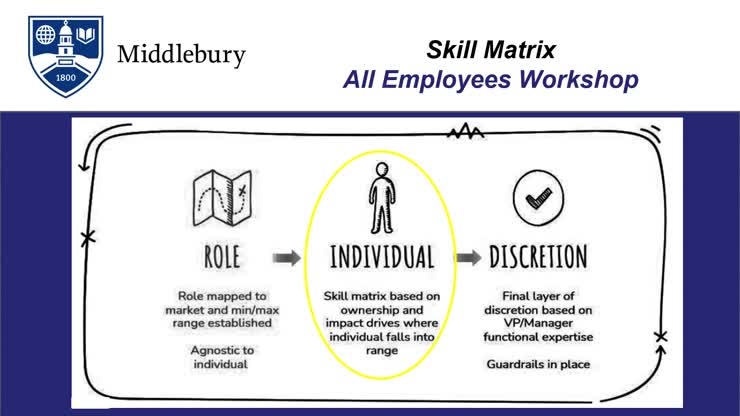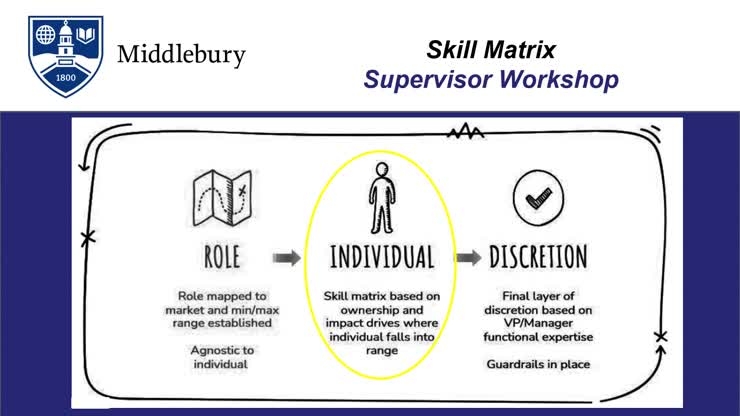Skill Matrix
What is Skill Matrix?
Our compensation program is designed to provide fair and competitive wages throughout a staff member’s career at Middlebury. From that perspective, when it comes to assessing individual rates of pay we begin with considering where an employee is in their overall career progression. Placement into range is managed with a skill matrix (below) focused on the impact and ownership shown in their role. This is step two in the process, once the range is established.
More information can be found at https://www.middlebury.edu/individual
Frequently Asked Questions
Q How do we ensure equity and transparency?
The first step around role is completely agnostic to individual in the role. The role is based on the job description, requirements of the position, scope of the responsibility, etc. This structure is designed to avoid any situation where one person would be favored over another in the same role. Increases will be based upon the market and skill matrix. If no increase is warranted it is because the position is already being compensated appropriately based upon those factors.
Q What is the process for completing the skill matrix and who will be making those decisions? Will I have input?
SLG members have been charged with managing the process because Middlebury is a large and there are many different management structures there may be some variation in how the process unfolds. HR has asked that SLG members work together with their leadership teams to assess career progression in the skill matrix for the employees in their area. The responsibility for the assessment lies with the management team and there should be a discussion with the staff member about their placement once our institutional collection and review process is complete.
Q Will managers have to complete the skill matrix for their direct reports every year?
Yes. Managers will complete a skill matrix each year. This will be an opportunity for managers and employees to discuss the employee’s career progression.
Q What will the process for future skill matrix assessments look like and when will that process occur?
Managers should be in regular communication with staff about their work and career progression and the skill matrix is a resource for these conversations. As a part of the annual compensation process we will follow the same three step process discussed. Step1: We will update market information for Roles; Step 2: we will collect skill matrix information about individuals and Step 3: If available, discretionary adjustments may be made.
Q Can you explain what "provides leverage within and across the organization" in the Skill Matrix means?
This sentence was meant to describe an individual’s ability to influence outcomes – e.g. develop and “use” (leverage) relationships with others to obtain results or support for projects/goals; develop strategies, both individual and across departments, to deliver results, etc.
Q Can you dispute your skill level?
There is no appeal process regarding your skill level but managers and department leaders are available to discuss your placement.
Q Doesn't the skill matrix really reflect performance?
The skill matrix reflects:
- Where you are in terms of your overall career progression, it is about the arc of your career, not one year.
- Your skill development and your level of ownership and impact in the role over a proven, consistent period of time.
Q How will the skill matrix be applied?
Leaders and supervisors should ask themselves and their teams this question: Who on your team has achieved significant career progression in the past year in terms of ownership and impact?
Once you have this list, pressure test it. Does each person stand out as achieving a significant career milestone this year? Or were they put forward because of a specific, annual contribution that should be recognized but not through the skill matrix? Refine the list.
Once refined, check again. Can you explain why this individual or these individuals should move? Can you speak to why others are not moving?
Finally, are you aligned with your leadership and supervisors? It is critical that you are working WITH your leaders and not in a vacuum.
Q Who has the final responsibility/authority for skill matrix placement?
Responsibility and authority sits with the SLG member who is completing the Step 2: INDIVIDUAL in Axiom as part of the compensation process.
It is critical that SLG members work with and align with leaders/supervisors in making decisions. SLG members have final authority but should be able to explain if there is a difference of opinion. It’s important we use this waterfall approach to ensure that clear and consistent messages are communicated from leadership to individual employees



